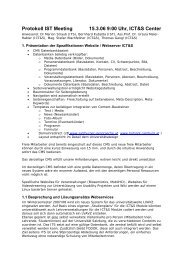CHRISTIAN FUCHS - ICT&S - Universität Salzburg
CHRISTIAN FUCHS - ICT&S - Universität Salzburg
CHRISTIAN FUCHS - ICT&S - Universität Salzburg
Create successful ePaper yourself
Turn your PDF publications into a flip-book with our unique Google optimized e-Paper software.
Christian Fuchs: Social Networking Sites and the Surveillance Society“Given these indicators, we find support for the idea that Facebook members areusing the site to engage in social searches, i.e. find out more about people in theiroffline communities. Social browsing, finding people online for offlineencounters, was widely reported as an unlikely use by the survey respondents“(Lampe/Ellison/Steinfield 2006a: 170).Lampe, Ellison and Steinfield (2006b) analyzed 30773 Facebook profiles. They foundthat“there is an association between how many items a person lists in their openendedprofile fields and the number of friendship links they have. (...) We foundthat populating profile fields on Facebook is positively related to the number offriends a user will have listed. The amount of information posted in open-endedfields does not affect the number of friends when added to the indices of thepresence of information in the profile fields“ (Lampe/Ellison/Steinfield 2006b:441).Referent information (hometown, high school, residence, field of study) had the greatestpositive influence on the number of friends, followed by contact information(relationship status, type of contacts one looks for, website, address, birthday, AIM,email), and interests (interests, music, books, TV shows, movies, political views,favourite quotes, about me).Valkenburg, Jochen and Alexander (2006) have conducted a psychological survey ofISNS users (N=881) and found that positive feedback on profiles enhances adolescents’self-esteem and wellbeing, whereas negative feedback decreases self-esteem andwellbeing.Di Gennaro and Dutton (2007) present data from the Oxford Internet Survey that showsthat in 2005, 20 percent of British Internet users, which are 12 percent of all Britons,have met new people online. They predict that the rise of social networking sites willfurther advance this rate.Humphreys (2007) used participant observation, user observations, and in-depthinterviews, for studying the use of the mobile SNS Dodgeball (N=21). He found thatDodgeball enabled users to “coordinate face-to-face meetings among groups of friends”and that third spaces (certain bars, cafés) emerged that “allow for habitual, dynamic,and technologically-enabled face-to-face interaction among loosely tied groups offriends”.“Dodgeball is not contributing to the further atomization of mobile phone users inpublic spaces, but it is not necessarily contributing to their collectivization, either.Instead, Dodgeball is primarily connecting Dodgeball users to one another andnot to the general urban public, thus leading to a kind of social molecularization.As an MSNS, Dodgeball becomes another means of maintaining and reinforcingsocial bonds. Even when my informants did meet new people through Dodgeball,these people were fairly demographically similar. While urban areas are diverseenvironments, Dodgeball may contribute to an illusion of ‘looser’ sociality despitereinforcing homophilous tendencies” (Humphreys 2007).19









